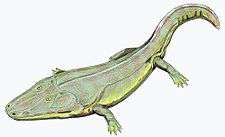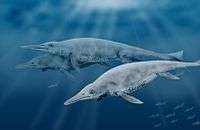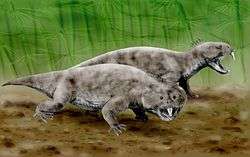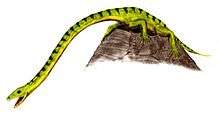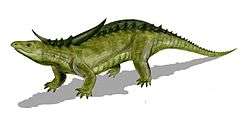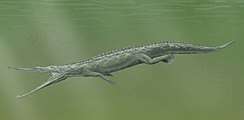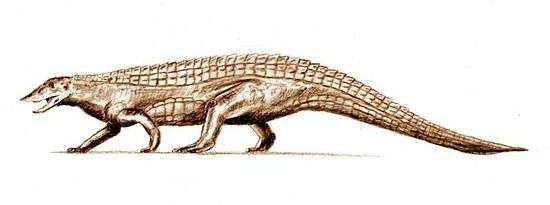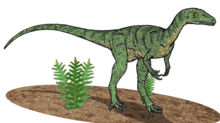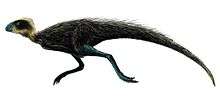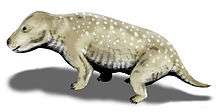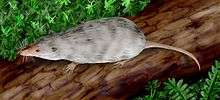Carnian
| System/ Period |
Series/ Epoch |
Stage/ Age |
Age (Ma) | |
|---|---|---|---|---|
| Jurassic | Lower/ Early |
Hettangian | younger | |
| Triassic | Upper/ Late |
Rhaetian | 201.3 | ~208.5 |
| Norian | ~208.5 | ~227 | ||
| Carnian | ~227 | ~237 | ||
| Middle | Ladinian | ~237 | ~242 | |
| Anisian | ~242 | 247.2 | ||
| Lower/ Early |
Olenekian | 247.2 | 251.2 | |
| Induan | 251.2 | 251.902 | ||
| Permian | Lopingian | Changhsingian | older | |
| Subdivision of the Triassic system according to the ICS, as of 2018.[1] | ||||
The Carnian (less commonly, Karnian) is the lowermost stage of the Upper Triassic series (or earliest age of the Late Triassic epoch). It lasted from 237 to 227 million years ago (Ma).[2] The Carnian is preceded by the Ladinian and is followed by the Norian. Its boundaries are not characterized by major extinctions or biotic turnovers, but a climatic event (known as the Carnian Pluvial Event) occurred during the Carnian and seems to be associated with important extinctions or biotic radiations.
Stratigraphic definitions
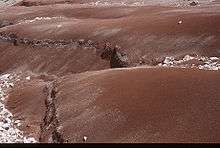

The Carnian was named in 1869 by Mojsisovics. It is unclear if it was named after the Carnic Alps or after the Austrian region of Carinthia (Kärnten in German)[3] or after the Carnia historical region in northwestern Italy. The name, however, was first used referring to a part of the Hallstatt Limestone cropping out in Austria.[3]
The base of the Carnian stage is defined as the place in the stratigraphic record where the ammonite species Daxatina canadensis first appears. The global reference profile for the base is located at the Stuores-Wiesen near Badia in the Val Badia in the region of South Tyrol, Italy.[4]
The top of the Carnian (the base of the Norian) is at the bases of the ammonite biozones of Klamathites macrolobatus or Stikinoceras kerri and the conodont biozones of Metapolygnathus communisti or Metapolygnathus primitius.
Dating and subdivisions
There is no established, standard usage for the Carnian subdivisions, thus, while in some regional stratigraphies a two-substage subdivision is common:
- Julian
- Tuvalian
others prefer a three-substage organization of the stage as follows:
- Cordevolian
- Julian
- Tuvalian
Biostratigraphy
In the Tethys domain, the Carnian stage contains six ammonite biozones:
- zone of Anatropites spinosus
- zone of Tropites subbullatus
- zone of Tropites dilleri
- zone of Austrotrachyceras austriacum
- zone of Trachyceras
Paleogeography and climate
The paleogeography of the Carnian was basically the same as for the rest of the Triassic. Most continents were merged into the supercontinent Pangaea, and there was a single global ocean, Panthalassa. The global ocean had a western branch at tropical latitudes called Paleo-Tethys. The sediments of Paleo-Tethys now crop out in southeastern Europe, in the Middle East, in the Himalayas, and up to the island of Timor.
The extreme land-sea distribution led to "mega-monsoons", i.e., an atmospheric monsoon regime more intense than the present one.
As for most of the Mesozoic, there were no ice caps. Climate was mostly arid in the tropics, but an episode of wet tropical climate is documented at least in the Paleo-Tethys. This putative climatic event is called the “Carnian Pluvial Event”, its age being between latest early Carnian (Julian) and the beginning of late Carnian (Tuvalian).
Life
In the marine realm, the Carnian saw the first abundant occurrences of calcareous nannoplankton, a morphological group including the Coccolithophores.
Invertebrates
There are a few invertebrates which are typical and characteristic of the Carnian. Among molluscs, the ammonoid genus Trachyceras is exclusive to the lower Carnian (i.e., Julian of the two-substages subdivision, see above). The family Tropitidae and the genus Tropites appear at the base of the upper Carnian (Tuvalian). The bivalve genus Halobia, a bottom-dweller of deep sea environments, differentiated from Daonella at the beginning of this age. Scleractinian coral reefs, i.e., reefs with corals of the modern type, became relatively common for the first time in the Carnian.
Vertebrates
The earliest dinosaur Eoraptor originated slightly before the Carnian stage began around 230 Ma. The oldest well documented dinosaurian assemblage, in the Ischigualasto Formation of Argentina, is most probably late Carnian in age.
In this stage the archosaurs became the dominant faunas in the world, evolving into groups such as the phytosaurs, rhynchosaurs, aetosaurs, and rauisuchians. The first dinosaurs (and the pterosaur Carniadactylus) also appeared in this stage, and though at the time they were small and insignificant, they diversified rapidly and would dominate the fauna for the rest of the Mesozoic. On the other hand, the therapsids, which included the ancestors of mammals, decreased in both size and diversity, and would remain relatively small until the extinction of the dinosaurs.
Conodonts were present in Triassic marine sediments. Paragondolella polygnathiformis appeared at the base of the Carnian stage, and is perhaps the most characteristic species. A partial list of Carnian vertebrates is given below.
Many Carnian vertebrates are found in Santa Maria Formation rocks of the Paleorrota geopark.
Temnospondyls
| Temnospondyls of the Carnian | ||||
|---|---|---|---|---|
| Taxa | Presence | Location | Description | Images |
| All Across Europe |
| |||
| Australia | ||||
| All across the USA and India | ||||
| Europe and North America | ||||
†Ichthyosaurs
| Ichthyosaurs of the Carnian | ||||
|---|---|---|---|---|
| Taxa | Presence | Location | Description | Images |
|
| ||||
†Archosauromorphs (non-archosaurian)
| Non-Archosaurian Archosauromorphs of the Carnian | ||||
|---|---|---|---|---|
| Taxa | Presence | Location | Description | Images |
| Paleorrota, Brazil. |
| |||
Archosaurs
| Suchians of the Ladinian | ||||
|---|---|---|---|---|
| Taxa | Presence | Location | Description | Images |
| All across Europe | Zanclodon is the name formally used for fossil material that might actually belongs to at least two genera of dinosaur from the Late Triassic among other genera. | |||
†Crurotarsans (non-crocodylomorphan)
| †Non-crocodylomorph Crurotarsans of the Carnian | ||||
|---|---|---|---|---|
| Taxa | Presence | Location | Description | Images |
|
| ||||
Crocodylomorphs
| Crocodylomorphs of the Carnian | ||||
|---|---|---|---|---|
| Taxa | Presence | Location | Description | Images |
|
| ||||
†Ornithodirans (non-dinosaurian)
| †Non-Dinosaurian Ornithodira of the Carnian | ||||
|---|---|---|---|---|
| Taxa | Presence | Location | Description | Images |
| Agudo, Rio Grande do Sul, Brazil |
| |||
| Silesia, Poland | ||||
Dinosaurs
| †Dinosaurs of the Carnian | ||||
|---|---|---|---|---|
| Taxa | Presence | Location | Description | Images |
| Disputed: considered Norian by some researchers. | Lesotho |
| ||
| Tecovas Formation, Texas | possibly a synonym of Chindesaurus | |||
| Colorado City Formation, Texas, USA | ||||
| Argentina | ||||
| Disputed: considered Norian by some researchers. | Lesotho, South Africa, Zimbabwe | |||
| Paleorrota, Brazil. | ||||
| Argentina | ||||
| Ischigualasto Formation, San Juan, Argentina | A small, lightly built dinosaur approximately 1 m (3 ft 3 in) in length and 30 cm (12 in) in height. It was bipedal and, like all ornithischians, was probably exclusively herbivorous. | |||
| Paleorrota, Rio Grande do Sul, Brazil. | May have been a primitive sauropodomorph, probably grew to about 1.5 meters (5 ft) long. | |||
| Paleorrota, Rio Grande do Sul, Brazil. | ||||
†Therapsids (non-mammalian)
| †Non-mammalian Therapsids of the Carnian | ||||
|---|---|---|---|---|
| Taxa | Presence | Location | Description | Images |
| Paleorrota, Brazil. |
| |||
Mammalia
| Mammalia of the Carnian | ||||
|---|---|---|---|---|
| Taxa | Presence | Location | Discussion | Images |
| Tecovas formation, Texas, USA | Some writers consider Adelobasileus to be a mammal,[5] while those who limit Mammalia to the crown group do not include this genus. In any case, Adelobasileus is thought to be either the common ancestor of all modern mammals or else a close relative of that ancestor. |
| ||
†Thalattosaurians
| Thalattosauria of the Carnian | ||||
|---|---|---|---|---|
| Taxa | Presence | Location | Description | Images |
| Falang Formation, Guizhou, China | A relatively large thalattosaurian, more than 4 meters long. |
| ||
Classic localities and lagerstätten
The lower Carnian fauna of the San Cassiano Formation (Dolomites, northern Italy) has been studied since the 19th century. Fossiliferous localities are many, and are distributed mostly in the surroundings of Cortina d'Ampezzo and in the high Badia Valley, near the village of San Cassiano, after which the formation was named. This fauna is extremely diverse, including ammonoids, gastropods, bivalves, echinoderms, calcareous sponge, corals, brachiopods, and a variety of less common fossils. A collection of this fauna is exposed in the “Museo delle Regole”, a museum in Cortina d'Ampezzo.
The Ischigualasto Formation of northwestern Argentina yielded a very important vertebrate association, including the oldest dinosaurian assemblage.
See also
- Paleorrota
References
Notes
- ↑ "International Chronostratigraphic Chart" (PDF). International Commission on Stratigraphy. 2018.
- ↑ http://www.stratigraphy.org/index.php/ics-chart-timescale
- 1 2 Gradstein, F.M.; Ogg, J.G.; Schmitz, M.D.; Ogg, G.M. (editors) (2012). The Geologic Timescale 2012 (volume 1). Elsevier. p. 687. ISBN 978-0-44-459390-0.
- ↑ The GSSP was firstly proposed by Broglio Loriga et al. (1999) and established by Mietto et al. (2012)
- ↑ Lucas and Luo (1993).
Literature
- Brack, P.; Rieber, H.; Nicora, A. & Mundil, R.; 2005: The Global boundary Stratotype Section and Point (GSSP) of the Ladinian Stage (Middle Triassic) at Bagolino (Southern Alps, Northern Italy) and its implications for the Triassic time scale, Episodes 28(4), pp. 233–244.
- Broglio Loriga, C.; Cirilli, S.; De Zanche, V.; Di Bari, D.; Gianolla, P.; Laghi, G.; Manfrin, S.; Mastandrea, A.; Mietto, P.; Muttoni, G.; Neri, C.; Posenato, R.; Rechichi, M.C.; Rettori R. & Roghi, G.; 1999: The Prati di Stuores/Stuores Wiesen section (Dolomites, Italy): a candidate Global Stratotype section and Point for the base of the Carnian stage, Rivista Italiana di Paleontologia e Stratigrafia 105, pp. 37–78.
- Furin, S.; Preto, N.; Rigo, M.; Roghi, G.; Gianolla, P.; Crowley, J.L. & Bowring, S.A.; 2006: High-precision U-Pb zircon age from the Triassic of Italy: Implications for the Triassic time scale and the Carnian origin of calcareous nannoplankton and dinosaurs, Geology 34, p. 1009-1012.
- Gradstein, F.M.; Ogg, J.G. & Smith, A.G.; 2004: A Geologic Time Scale 2004, Cambridge University Press.
- Gradstein, F.M.; Ogg, J.G., Schmitz, M.D. & Ogg, G.M.; 2012: The Geologic Time Scale 2012, Elsevier.
- Lucas, S.G.; Luo, Zhe-Xi; 1993: Adelobasileus from the upper Triassic of west Texas: the oldest mammal, J. Vert. Paleont. 13, pp. 309–334.
- Mietto, P.; Manfrin, S.; Preto, N.; Rigo, M.; Roghi, G.; Furin, S.; Gianolla, P.; Posenato, R.; Muttoni, G.; Nicora, A.; Buratti, N.; Cirilli, S.; Spoetl, C.; Ramezani, J. & Bowring, S.A.; 2012: The Global Boundary Stratotype Section and Point (GSSP) of the Carnian stage (Late Triassic) at Prati di Stuores/Stuores Wiesen section (Southern Alps, NE Italy), Episodes 35, pp. 414–430.
External links
- GeoWhen Database - Carnian
- Upper Triassic timescale, at the website of the subcommission for stratigraphic information of the ICS
- Norges Network of offshore records of geology and stratigraphy: Stratigraphic charts for the Triassic, , and
- Palaeos Mesozoic: Carnian Age
